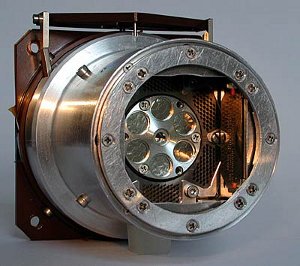The chemical element curium is classed as an actinide metal. It was discovered in 1944 by Glenn T. Seaborg, Ralph A.James, and Albert Ghiorso.

Data Zone
| Classification: | Curium is an actinide metal |
| Color: | silvery-white |
| Atomic weight: | (247), no stable isotopes |
| State: | solid |
| Melting point: | 1340 oC , 1613 K |
| Boiling point: | 3100 oC , 3373 K |
| Electrons: | 96 |
| Protons: | 96 |
| Neutrons in most abundant isotope: | 151 |
| Electron shells: | 2,8,18,32,25,9,2 |
| Electron configuration: | [Rn] 5f7 6d1 7s2 |
| Density @ 20oC: | 13.5 g/cm3 |
Compounds, Radii, Conductivities
| Atomic volume: | 18.28 cm3/mol |
| Structure: | fcc: face-centered cubic |
| Hardness: | |
| Specific heat capacity | – |
| Heat of fusion | – |
| Heat of atomization | – |
| Heat of vaporization | – |
| 1st ionization energy | 581 kJ mol-1 |
| 2nd ionization energy | – |
| 3rd ionization energy | – |
| Electron affinity | – |
| Minimum oxidation number | 0 |
| Min. common oxidation no. | 0 |
| Maximum oxidation number | 4 |
| Max. common oxidation no. | 3 |
| Electronegativity (Pauling Scale) | 1.3 |
| Polarizability volume | 23 Å3 |
| Reaction with air | |
| Reaction with 15 M HNO3 | |
| Reaction with 6 M HCl | |
| Reaction with 6 M NaOH | |
| Oxide(s) | CmO, Cm2O3, CmO2 |
| Hydride(s) | CmH2 |
| Chloride(s) | CmCl3 |
| Atomic radius | 174 pm |
| Ionic radius (1+ ion) | – |
| Ionic radius (2+ ion) | – |
| Ionic radius (3+ ion) | 111 pm |
| Ionic radius (1- ion) | – |
| Ionic radius (2- ion) | – |
| Ionic radius (3- ion) | – |
| Thermal conductivity | – |
| Electrical conductivity | – |
| Freezing/Melting point: | 1340 oC , 1613 K |

The Berkeley Lab’s 60-inch cyclotron, where atoms of curium were synthesized for the first time. Ernest Lawrence, the cyclotron’s inventor, is on the right.
Discovery of Curium
Curium was the third synthetic transuranium element of the actinide series to be discovered.
It was discovered by Glenn T. Seaborg, Ralph A.James, and Albert Ghiorso in 1944.
Curium-242 (half-life 162.8 days) was produced by bombarding plutonium-239 with alpha particles in the Berkeley, California, 60-inch cyclotron. Each nuclear reaction produced a neutron in addition to an atom of curium-242. (1)
The element was chemically identified at the metallurgical laboratory at the University of Chicago.
The researchers at first referred to curium as ‘delirium’ owing to the difficulties they encountered trying to isolate it from another new element with which it was very closely associated, americium – or ‘pandemonium’ as it was first called.
Visible amounts of curium-242, in the form of curium hydroxide, were first isolated by Louis Werner and Isadore Perlman of the University of California in 1947. Curium-242 was produced by bombarding americium-241 with slow moving neutrons for a year. (2)
In 1952, W. W. Crane, J. C. Wallmann, and Burris B. Cunningham prepared metallic curium for the first time at Berkeley, California. (3)
The element is named after Marie and Pierre Curie, who pioneered work on radioactivity and discovered radium and polonium.


The Alpha Particle X-Ray Spectrometer (APXS) used on the Mars Exploration Rovers. It uses small amounts of curium-244 to determine the concentrations of most major elements in rocks and soil.(Photo credit: NASA)
Appearance and Characteristics
Harmful effects:
Curium is harmful due to its radioactivity. It accumulates in bones and destroys the marrow, stopping the formation of red blood cells.
Characteristics:
Curium is a hard, dense radioactive silvery-white metal.
It tarnishes slowly in dry air at room temperature.
Most compounds of trivalent curium are slightly yellow in color.
Curium is highly radioactive and it glows red in the dark. (4)
Uses of Curium
Curium is used mainly for scientific research purposes.
Curium-244 was used in the Alpha Proton X-ray Spectrometer (APXS) which measured the abundance of chemical elements in rocks and soils on Mars.
Curium-244 is a strong alpha emitter and is being studied as a potential power source in radioisotope thermoelectric generators (RTGs) for use in spacecraft and other remote applications.
Abundance and Isotopes
Abundance earth’s crust: nil
Abundance solar system: unknown
Cost, pure: $ per g
Cost, bulk: per 100g
Source: Curium does not exist in nature. It is a synthetic element and it is produced in nuclear reactors by bombarding plutonium with neutrons.
Isotopes: Curium has 15 isotopes whose half-lives are known, with mass numbers 238 to 252. Curium has no naturally occurring isotopes. Its longest lived isotopes are 247Cm, with a half-life of 15.6 million years, 248Cm with a half-life of 340,000 years and 250Cm with a half-life of 9,000 years.

References
- Thomas K. Keenan, Americium and Curium., Journal of Chemical Education 36.1 (1959) p27.
- J. C. Wallmann, The First Isolations of the Transuranium Elements., Journal of Chemical Education 36.7 (1959) p343.
- Glenn Theodore Seaborg, The transuranium elements ., Taylor & Francis, 1958., page 93
- Open Learn Labspace
Cite this Page
For online linking, please copy and paste one of the following:
<a href="https://www.chemicool.com/elements/curium.html">Curium</a>
or
<a href="https://www.chemicool.com/elements/curium.html">Curium Element Facts</a>
To cite this page in an academic document, please use the following MLA compliant citation:
"Curium." Chemicool Periodic Table. Chemicool.com. 16 Oct. 2012. Web. <https://www.chemicool.com/elements/curium.html>.